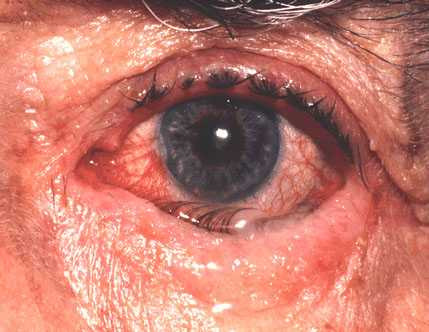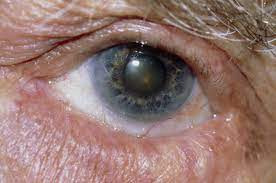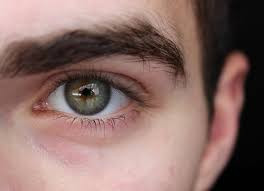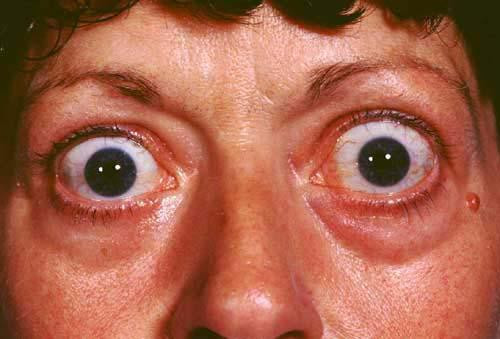Definition
Ectropion is a condition where the eyelid turns outward, exposing the surface of the eye to irritants and increasing the risk of irritation. This condition is more common in the elderly and typically affects the lower eyelid. In severe cases, the entire eyelid may fold outward, while in milder cases, only a small portion of the eyelid is affected. While using artificial tears can alleviate dry eye symptoms associated with ectropion, surgery is often necessary to fully correct the condition.
Causes
Normally, when you blink, your eyelids help distribute tears evenly across the surface of your eye, keeping it moist. These tears are then drained into small openings called puncta located at the inner corner of the eyelid. In ectropion, the lower eyelid fails to properly distribute tears, leading to poor tear drainage and causing dry, watery eyes.
Several factors can contribute to the development of ectropion:
- Muscle weakness. Aging can weaken the muscles and stretch the tendons that hold the eyelids in place. These muscles and tendons help hold your eyelids in place. When these muscles become weak, they lead to drooping eyelids.
- Facial paralysis. Conditions like Bell's palsy or certain tumors can cause paralysis or stiffness in the facial muscles, including those that control the eyelids, resulting in ectropion.
- Injuries or surgical scars. Injuries, surgeries (such as blepharoplasty), or significant trauma (e.g., animal bites) that alter the skin around the eyes can change the position of the eyelids and cause ectropion, especially if a large amount of skin is involved.
- Eyelid tumors. Both benign and malignant tumors on the eyelids can cause them to droop.
- Genetic disorders. Ectropion can be congenital (present from birth) and may be associated with conditions like Down syndrome.
Risk Factors
Several factors increase the risk of developing ectropion:
- Age. Muscle weakness due to aging is the primary cause of ectropion.
- Eye surgery. A history of eye or eyelid surgery increases the risk of developing ectropion.
- Cancer, burns, and injuries from accidents. Skin cancer on the face, facial burns, and traumatic injuries to the facial skin also raise the risk of ectropion.
Symptoms
Common symptoms of ectropion include:
- Constantly watery eyes
- Recurrent dry eyes
- Eye irritation
- Sensitivity to light
Diagnosis
Ectropion can often be diagnosed during a routine clinical eye examination. Your doctor will inquire about the duration of your symptoms, including irritation, redness, and any history of facial burns, prior eyelid surgeries, or trauma. A physical examination will be conducted to assess your visual acuity, as well as an examination of the conjunctiva and cornea using a slit lamp. Additionally, the doctor may pull on your eyelids to evaluate their elasticity. This examination aims to confirm the diagnosis and identify any complications affecting your cornea.
Management
For mild ectropion, your doctor may suggest using artificial tears to relieve symptoms. However, surgery is often necessary to correct the eyelid's position.
Surgery
The surgical approach depends on the condition of the tissue around your eyelid:
- Ectropion due to muscle and ligament weakness related to aging. The doctor will remove a small portion of the eyelid on the outer side. Reattaching the eyelid will tighten the tendons and muscles, allowing the eyelid to cover the eye properly again.
- Ectropion caused by traumatic scarring. A skin graft or additional skin from your upper eyelid or behind your ear may be needed to support the lower eyelid. Multiple surgeries may be required if facial paralysis or significant scarring is present.
Before the surgery, a local anesthetic will be administered to numb the area around your eye. Post-surgery care involves wearing eye protection for 24 hours, using antibiotics several times a week, and applying cold compresses if there is bothersome swelling. You may experience temporary swelling and tightness in the eyelids, which typically subsides within two weeks.
Home Care
Certain lifestyle changes can help ease discomfort associated with ectropion:
- Using Artificial Tears: Regular use of artificial tears can keep your cornea and eyeball surface moisturized, preventing damage that might impair vision. It is particularly important to use these drops at night.
- Caution When Rubbing Your Eyes: Avoid rubbing your eyes excessively, as this can strain the muscles and tendons, worsening ectropion. Develop the habit of rubbing your eyes gently, from the outside inwards.
Complications
Ectropion can lead to corneal irritation and exposure to irritants due to dry eyes. Prolonged irritation and dry eye conditions can result in complications such as conjunctivitis, corneal ulceration, and corneal abrasions, which may permanently impair vision. Surgical complications may include bleeding, infection, pain, and weak repositioning.
Prevention
Although ectropion is generally unpreventable, its progression and recurrence can be minimized by being cautious when pulling the eyelids to apply eye drops and avoiding vigorous rubbing. Additionally, sleeping on the side with ectropion or on your back may help.
When to See a Doctor?
Seek medical attention if you experience symptoms of ectropion, particularly if it is accompanied by dry eyes that interfere with daily activities, redness, blurred vision, or eye pain.
Looking for more information about other diseases? Click here!
- dr Ayu Munawaroh, MKK
Mayo Clinic. (2021). Ectropion. Mayoclinic. Retrieved 06 November 2021, from https://www.mayoclinic.org/diseases-conditions/ectropion/diagnosis-treatment/drc-20351169.
Ing ED. (2018). Ectropion Clinical Presentation. Medscape. Retrieved 06 November 2021, from https://emedicine.medscape.com/article/1212398-clinical#b1.
Pietrangelo A. (2020). Ectropion. Healthline. Retrieved 06 November 2021, from https://www.healthline.com/health/ectropion.
American Society of Ophthalmic Plastic and Reconstructive Surgery. (2018). Out-turned eyelid (ectropion). ASOPRS. Retrieved 06 November 2021, from https://www.asoprs.org/ectropion.












